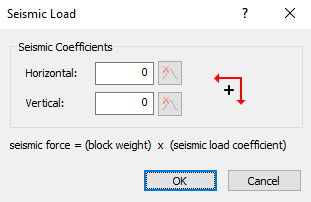Applying/Editing Seismic Loads
The Seismic Load  option in the Loading menu allows you to apply pseudo-static earthquake forces in the RocTopple limit equilibrium analysis by defining seismic coefficients for the Horizontal and / or Vertical directions. The Seismic Coefficients are dimensionless coefficients which represent the (maximum) earthquake acceleration as a fraction of the acceleration due to gravity. Typical values are in the range of 0.1 to 0.3.
option in the Loading menu allows you to apply pseudo-static earthquake forces in the RocTopple limit equilibrium analysis by defining seismic coefficients for the Horizontal and / or Vertical directions. The Seismic Coefficients are dimensionless coefficients which represent the (maximum) earthquake acceleration as a fraction of the acceleration due to gravity. Typical values are in the range of 0.1 to 0.3.
Applying a Seismic Load
- Select Seismic Load
 on the toolbar or the Loading menu.
on the toolbar or the Loading menu.
The Seismic Load dialog appears.
- Enter the Horizontal and / or Vertical Seismic Coefficients.
Note the positive convention (horizontal positive is directed OUT of the slope and vertical positive is directed DOWN). You can enter negative coefficients if you want to apply the seismic force in the opposite direction (horizontal IN to the slope or vertical UP). - Select OK to include the pseudo-static seismic load in your analysis.
SEISMIC COEFFICIENTS
When you apply the Seismic Coefficients, a pseudo-static force is applied through the centroid of each block in the horizontal and/or vertical directions. The applied force on each block is equal to:
Seismic Force = Seismic Coefficient * Block Weight * acceleration due to gravity
Note that the acceleration due to gravity (g = 9.81 m/s2 for metric units) is automatically accounted for in the analysis and does not need to be entered by the user. The Seismic Coefficients are dimensionless.
SEISMIC LOAD STATISTICS
If you are carrying out a Probabilistic analysis, the Seismic Coefficients (horizontal or vertical) can be defined as random variables. See Seismic Load Statistics in a Probabilistic Analysis for more information.
SENSITIVITY ANALYSIS
The Sensitivity analysis feature of RocTopple is useful to determine the effect of the Seismic Coefficients over any desired range of values. For example, you could enter a range of -0.5 to 0.5 to obtain a plot of Factor of Safety versus Seismic Coefficient over a range of possible values in both the positive and negative directions.
The Seismic Load Icon
When a seismic load is applied (i.e., the Horizontal and / or Vertical Seismic Coefficients are non-zero in the Seismic Load dialog), a Seismic Load icon, as shown below, appears in the upper-right corner of the 2D View. The magnitude and direction of the Seismic Coefficients are displayed together with the icon.
![]()
Modifying a Seismic Load
You can modify a seismic load by accessing the Seismic Load dialog through the Seismic Load icon.
- Right-click the Seismic Load icon in the upper-right corner of the 2D View.
- Select Modify Seismic Load on the popup menu to open the Seismic Load dialog.
- Edit the seismic load parameters as needed, referring to the parameter descriptions provided above.
- Click OK to save your changes